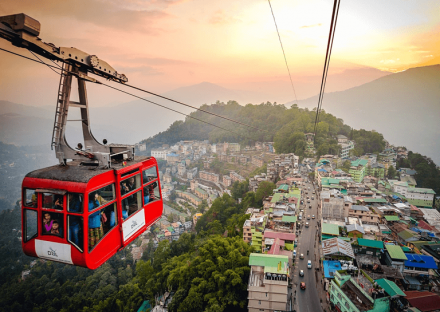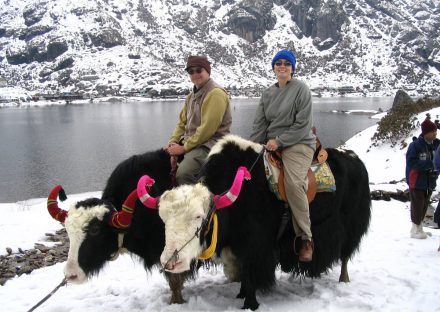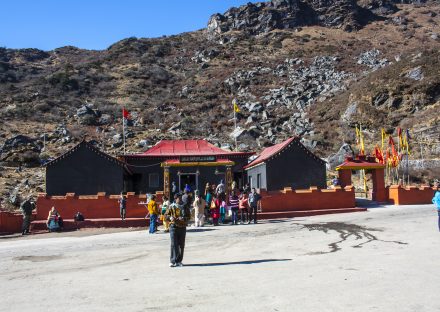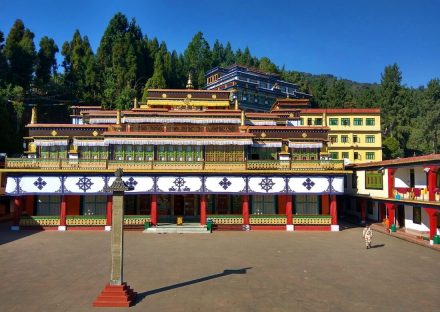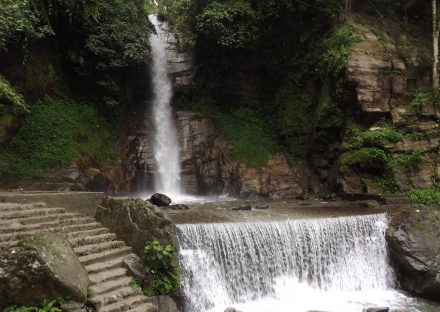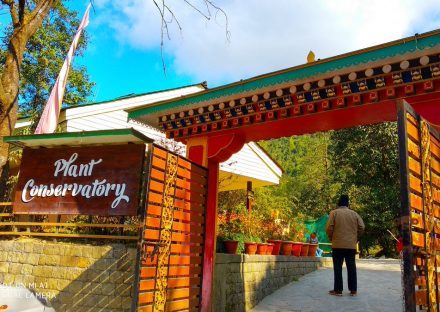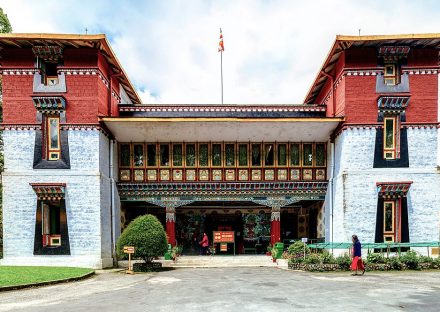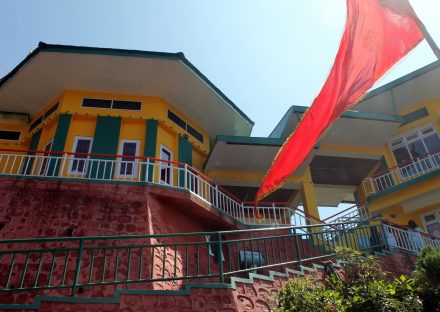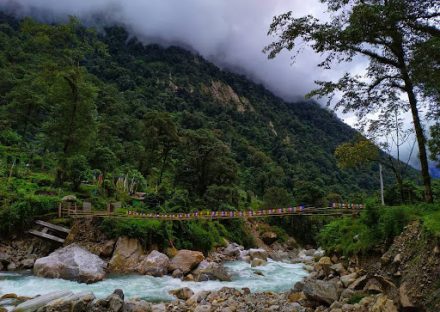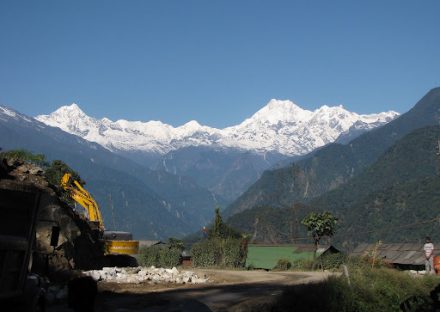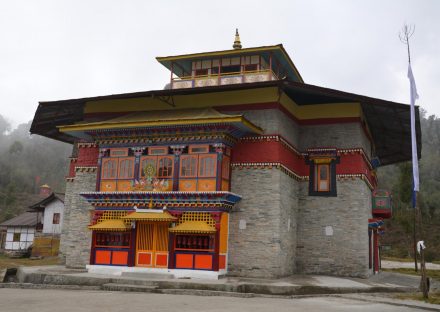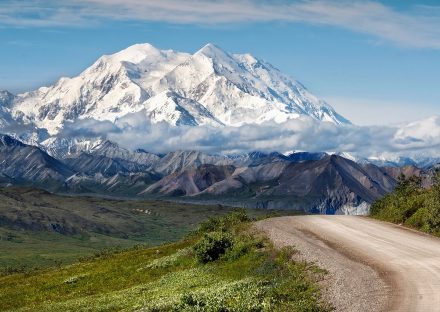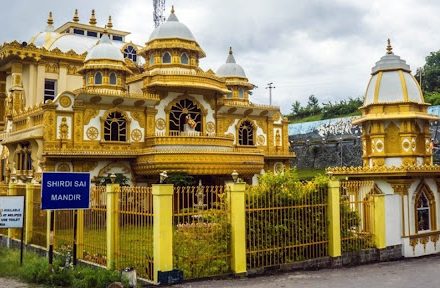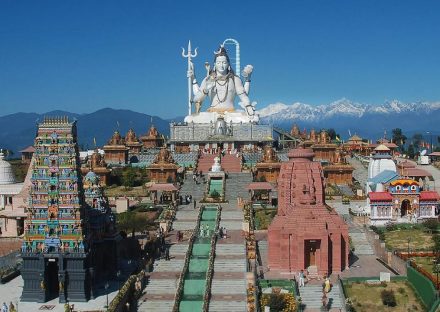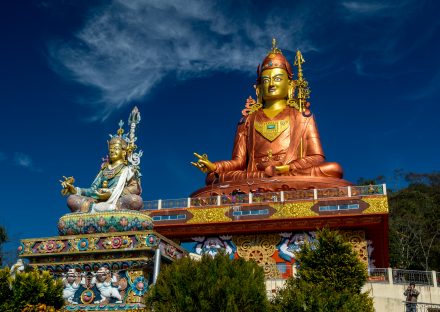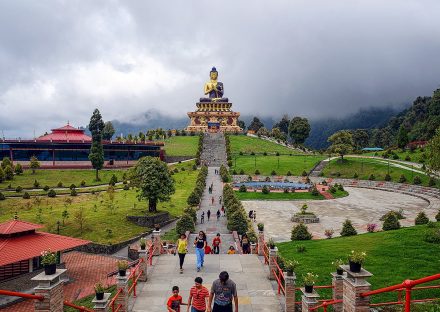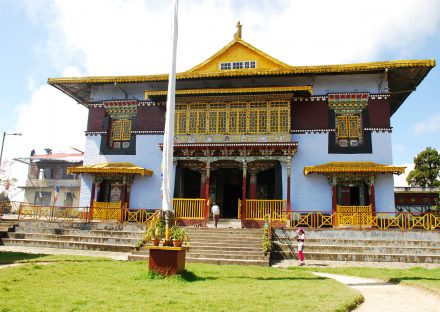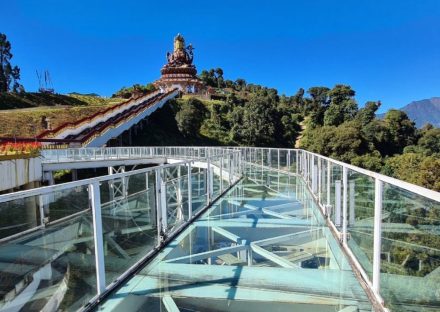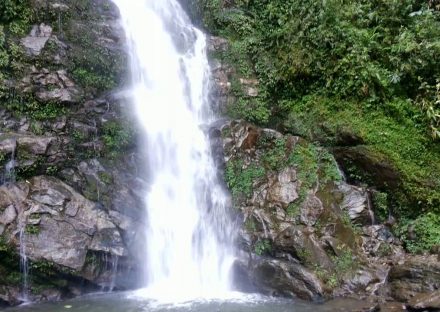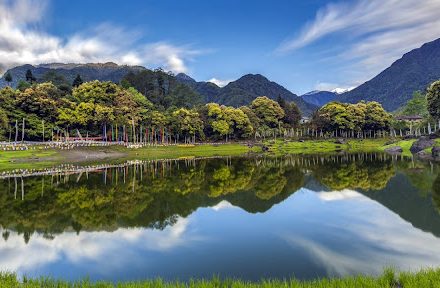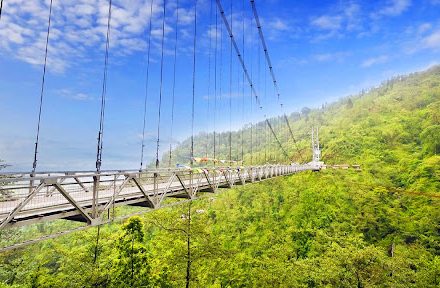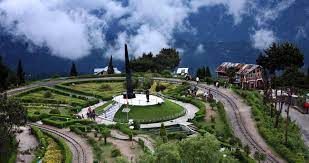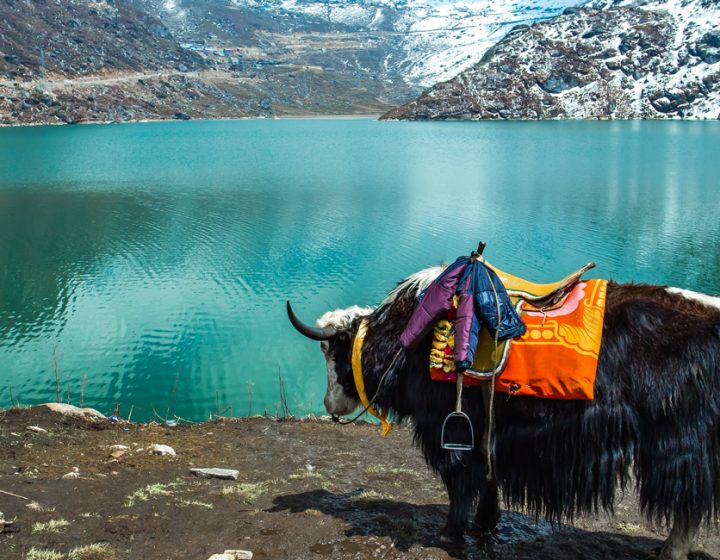Tour overview
3N GANGTOK 1N MANGAN 2N RAVANGLA 2N PELLING
Gangtok, Gangtok is the capital of the mountainous northern Indian state of Sikkim. Established as a Buddhist pilgrimage site in the 1840s, the city became capital of an independent monarchy after British rule ended, but joined India in 1975. Today, it remains a Tibetan Buddhist center and a base for hikers organizing permits and transport for treks through Sikkim’s Himalayan mountain ranges.
Mangan, Mangan is the capital of the district of North Sikkim in the Indian state of Sikkim. The town is connected to the capital Gangtok by a metalled road. North Sikkim is the largest district of Sikkim in terms of area. The town lies in the geographic south of the district.
Ravangla, Ravangla or Rawangla or Ravongla is a small tourist town with an elevation of 8000 feet located in the South Sikkim district of the Indian state of Sikkim. It is connected by state highway to other major towns in the state and lies between Pelling and Gangtok.
Pelling, Pelling is a small town in the northeastern Indian state of Sikkim, at the foothills of Mount Khangchendzonga. The late-17th-century Buddhist Sanga Choling Monastery has mountain views. Pemayangtse Monastery features wall paintings, sculptures and a gold-plated statue of Guru Padsambhava. Overlooking a valley, the 17th-century Rabdentse Palace, now in ruins, still has evidence of the king’s bedroom and kitchen.
Included
- All Toll Taxes, Parking fees and Driver's Expenses.
- Transportation mentioned in the itinerary.
- Hotel Booking, if required.
- Tour Manager.
Not Included
- Any Private Expenses.
- All other services not mentioned in the inclusions.
DAY 01 TRANSFER FROM (IXB) BAGDOGRA AIRPORT TO GANGTOK
Our representative cordially receives you on arrival at Siliguri,Bagdogra (IXB) Airport and helps you to board the car.
Gangtok is the capital of Sikkim. It is a modern city but with a great history and tradition. At 1,650 meters, Gangtok offers excellent weather throughout the year and offers multiple tourist attractions in and around the city. We assist you to check-in at the hotel. Overnight at Gangtok.
Recommended: Visit to M.G Marg, the main promenade of the city. There are plenty of shops and eateries in the nicely decorated road where locals and tourists visit during the evening. Visit to MG Marg is to be self.
Overnight stay at Hotel in Gangtok.
DAY 02 FULL DAY EXCURSION OF TSOMGO LAKE & BABA MANDIR
Next day You need to get up early, get fresh and have a heavy breakfast till 7.30am. You will be Picked up from the Hotel in Gangtok & then proceed for a full day excursion of Tsomgo Lake. Tsomgo Lake, also known as Changu Lake is a glacial lake in Sikkim. The name Tsomgo means 'Source of water'. It's located 40kms from Gangtok town and leads all the way to Nathula Pass. This is one of the few high-altitude lakes in India. Prior to 1962, this was part of the old trade route between India and China. It takes about 2 hours by car from Gangtok to reach the lake along the Kyongnosla Alpine Sanctuary, the home to the red panda and the blood pheasant with Rhododendron and other alpine trees along the road - Situated at an elevation of 3753 meters / 12310 feet - The Lake is oval shaped lake nearly 50 feet deep - Generally covered in snow for most of the year the year – This lake is home to the Brahminy ducks & many migratory birds – Enjoy playing in snow and Yak Ride. Proceed further to Legendary Baba Harbhajan Singh Mandir (“Hero of Nathula '' An Indian soldier who was awarded the Maha Vir Chakra medal for his bravery and known for doing his duty still after death).. Nearby is the sacred Baba Mandir known to be a very holy site for all. You can take a ride on colourfully adorned yaks and ponies. There is also a 957-meter long ropeway (cable car) that carries passengers from the lake to a hilltop nearby. You should reach Tsomgo Lake before noon because in the afternoon the weather here usually starts getting bad. Additionally, Nathula Pass (14,140 ft.) which is the Indo Chinese border can be combined in this trip on request by the passengers at an extra cost.
Back to the Hotel for a late Lunch.
** Kindly note the following points regarding visit to Nathula**
1. Nathula permits are limited; hence it is NOT a guaranteed trip.
2. If permits are issued, the additional cost to be paid by the passengers is approx. Rs. 3000 - Rs. 4000 per vehicle.
3. Nathula visit cost has not been included in this package.
4. If you have breathing problems, you are advised to consult a doctor before visiting these places (particularly Nathula) because of low oxygen at such high altitudes. Portable oxygen cylinders are available at Medical shops in Gangtok.
In the evening, return from Tsomgo Lake to Gangtok.
Overnight stay at Hotel in Gangtok.
DAY 03 FULL DAY GANGTOK EXCURSION
Places Include:
Ranka or Lingdum or Rumtek Monastery: About 45 minutes drive from Gangtok, set up on a hill and one of the most wonderful monasteries in east Sikkim.
Ban Jhakri Waterfall: A great waterfall in a landscaped forest garden. The place is an excellent picnic spot for families.
Tashi View point: A great view point for watching the Kanchenjunga Snow Peaks on a clear day. Also an excellent place for sunrise view.
Gonjang Monastery: Gonjang Monastery is located about 6 km away from the heart of Gangtok town near Tashi View point. It is situated at 27.36908 latitude and 88.613314 at an altitude of 6066 feet. The monastery was established in the year 1981 and the founder is H.E. Tingkye Gonjang Rimpoche. Monastic education along with Tibetan language and English are taught to the monk students. The monastery imparts knowledge on close and comparative studies of Indian and Tibetan Buddhist philosophy based on moral values. Gonjang Institute is a nine years course similar to other Nyingma Institute.
Plant Conservatory: The Plant Conservatory at Bulbulay near Gangtok stands in semi-wilderness on the road that connects Gangtok to Hanuman Tok. Sikkim is home to over 400 species of plants and trees, and the conservatory is intended to make the region a botanical hub of the future. For the layperson, the conservatory is merely an exotic garden growing naturally on the hillside. Placards give away the academic intent of this place and help visitors put names to the trees. One can identify trees such as the Dhuppi known for its fragrant resin and the omnipresent Angeri. The trees are interspersed with flowering plants like Hydrangeas, Orchids, Rhododendrons, Azaleas, Magnolias, and Daylilies. When in full bloom, this garden is a multi-sensory treat. The conservatory is home to beautiful ponds and bridges and is surrounded in greenery wherever the eyes go. With a backdrop of the mighty Himalayas, this Plant Conservatory’s picturesque setting is worth a visit.
Enchey Monastery: Located on a hilltop, it's one of the oldest monasteries around.
Ganesh Tok: A Ganesh Temple with viewing lounge and open balcony.
Ropeway (Cable Car): Great ride to view the whole of Gangtok, the valley and the peaks from far above.
Institute of Tibetology: A world famous institute doing research on Tibetan language and culture also has a great museum and library with rare and huge collections. It's located within a short walk from Chorten Stupa.
Handicraft Center: This is the building of Directorate of Handicraft & Handloom including a Sales emporium and a Museum showcasing many different handicraft items and artwork created by the local artists and craftsmen.
Overnight stay at Hotel in Gangtok.
DAY 04 TRANSFER TO MANGAN SIGHTSEEING
After an early morning breakfast we continue our tour to the next beautiful destination Mangan. Where we will visit some places And then transfer for hotel Check-in.
Mangan Marvelous and panoramic, Mangan is a small town arranged in North Sikkim district. Filling in as North Sikkim’s territorial capital, this scaled down hill station is a mainstream trekking destination for passionate meanders’, experience oddities and nature sweethearts. Take the metalled street from Gangtok to Mangan, this drive will transport you to an alternate world, so dreamlike. Witness the inconceivable magnificence of nature in the moving mountains, forested slopes, chattering streams and scattered settlements. On the off chance that you are looking for quietness and isolation, you will discover it here. Mangan, will without a doubt offer you with an amazingly ‘breakaway’ occasion. Take a voyage through this spot and make a visit to its dazzling tourism attractions. With few of the most stunning must see touring places, traveling crosswise over Mangan will be a joyride worth cherishing a lifetime.
Places Include:
Singhik: Singhik is a little settlement on a hill, around 1560 m above the ocean level, thought to be the most prominent place that offers the magnificent and unhampered views of Mt. Khangchendzonga and Mt. Siniolchu. The place accompanies many short nature treks alongside itself, the encompassing lavish green hills with higher edges gives the compensating elevated perspective of the combining purpose of River Teesta and River Kanaka at the foot slopes, that pulls in many experienced voyagers to come to Singhik. It is similarly prevalent among alternate travellers making a beeline for alternate goals of North Sikkim, who think about it as a perfect place for a night’s end in the midst of the extraordinary greenery and cluster of frosted mountains while the superb Teesta River sputters underneath it.
Labrang Monastery Mangan: Labrang Monastery is an antique structure that has an enchanting interest. This Buddhist sanctuary is very special despite everything it holds its unique structure, with its white dividers and plated rooftops done in the blended Tibet and Indian style of engineering. Inside the Labrang Monastery you can see the wall paintings at the petition lobby and in the event that you visit this fascination amid early December, you may witness the renowned Chaam Dance also. This must visit fascination was created to pay tribute to Latsun Chembo of Kongpu who began Nyingma School of Tibetan Buddhism. Labrang Monastery contains around six establishments, a plated stupa, 18 lobbies, a sutra banter zone and it likewise houses around 60,000 sutras. There is likewise an exhibition hall that has a gathering of Buddha statues, sutras and wall paintings, including Tibetan dialect books, recorded books, books on pharmaceuticals, music, crafts, timetables, calendars and so forth.
Sirijunga Yuma Manheim: Sirijunga Yuma Manheim, worked in the year 1983, is a carbon copy auxiliary outline to that of the Sirijonga Yuma Mangham of Martam in West Bengal. This wonderful building is caught in the midst of quiet nature, the perspective of the strong mountains discouraged by the reasonable mists; tremendous greenery retaining the chill for summer; and the valuable stream streaming in full freedom make this place an unquestionable visit while in Mangan. In spite of the fact that it has picked up ubiquity among sightseers particularly as a result of its intricate festival of Maghey Sankranti celebration amid the period of January consistently. During this time, the surge of travellers and the localites assemble here and participate in the different exercises and jollification. It is a celebration of Nepalese, celebrated on the principal day of the tenth month as indicated by the Bikram Sambat book.
Rong Lungten Lee Mangan: Nearly taking after the Lepcha customary house, the Rong Lungten Lee is situated in a beguiling destination of Nam Prik Dang. Sited at the intersection of two waterways, Kanaka and Teesta, Nam Prik Dang is known for its quiet condition, changed greenery and additionally the mainstream Sikkim yearly celebration Namsong. Here, the Rong Lungten Lee is generally visited by voyagers in light of its wonderful Sikkim legacy significance. If you appreciate going out for a stroll, Rong Lungten Lee is an awesome place to be as it shows some antiquated ancient rarities of the Lepcha clan. There are three rooms in Rong Lungteen and every one of these rooms’ houses things from the past, the Phodong which implies the storage room is utilized for putting away significant and old fashioned things.
Overnight Stay at Mangan.
DAY 05 EXCURSION TO NAMCHI & TRANSFER TO RAVANGLA
Early in the morning we continue our tour to the next best and most beautiful destination, Namchi. And then transfer for hotel Check-in in Ravangla.
Places Include:
Shirdi Sai Baba Mandir: Shirdi Sai Baba Mandir & Pilgrimage Centre is located at Asangthang, Namchi. This is the first Shai Baba temple in the whole of Sikkim. It was built by Shirdi Sai Baba Trust of South Sikkim under the patronage of the Government of Sikkim Tourism. It was opened for prayers on 3rd November 2010 by the Chief Minister of Sikkim Dr. Pawan Chamling. The temple is located at the corner of two roads. Although overall it's a striking complex with a garden setting with an awesome architecture with intricate work all around. Upstairs there is a wonderful statue of Shirdi Shai Baba kept on an elevated platform at the end of a huge hall. The hall with its blue decor & hue, and paintings & sculptures of many gods & goddesses around the walls is awe-inspiring. Downstairs is the large prayer room where devotees offer prayers. There is also an elevated stage at the end where kirtan and other religious functions take place that are organised by the trust.
Char Dham: Char Dham is undoubtedly the most popular and the best tourist attraction in Namchi. It is located on a hill top and about 5kms from the centre of town. This large complex has been conceived to take Sikkim to new heights of pilgrimage & religious tourism. The complex comprises the main temple of Shiva on which the imposing statue of Shiva has been set up. Additionally there are replicas of twelve jyotirlingas to offer one platform to all devotees of Shiva, as well as replicas of the four dhams (Badrinath, Jagannath, Dwarka dedicated to lord Vishnu and Rameshwar dedicated to lord Shiva).
Samdruptse: Samdruptse Monastery is about 7kms from Namchi town and up on Samdruptse hill. Before Char Dham, this used to be the main attraction of Namchi, it is still very popular among tourists. Samdruptse means 'Wish fulfilling Hill'. The locals believe that the hill is actually a dormant volcano. The Buddhists have been regularly offering prayers so that the volcano does not erupt. It has stayed calm so far. There is a mammoth 45-meter statue of Sikkim's patron saint Guru Padmasambhava set up on an elevated platform. The face is coated with gold that glitter in the sun. Walk around the platform and you can get a magnificent view of the mountains and forests. The entry to the monastery is from the backside. The foundation stone here was laid by the Dalai Lama on 22nd October 1997. Subsequently when the work started, it took over 3 years with many renowned architects, engineers and over 1,000 laborers who worked hard together to set up the statue and the monastery.
Overnight Stay at Ravangla.
DAY 06 EXCURSION OF RAVANGLA
Places Include:
Rayong Sunrise View Point: At a distance of 9 km from Ravangla, Rayong Sunrise Viewpoint is a viewpoint situated on Ravongla - Damthang Road. Situated on the way to Temi Tea Garden, it is one of the spectacular viewpoints in Ravangla and among the must visit Ravangla Tourist Places. Perched at an altitude of 6700 feet, Rayong Sunrise View Point offers breathtaking views of the Singalila range and the Chola range of Bhutan. The viewpoint also offers a mesmerizing sunrise view as the first rays of the sun lightens up the snowy peaks of Mount Narsing, Mount Jopuno, Mount Kabru, Mount Rathong, Mount Pandim and the rest of the Himalayan Range.
Along with lovely natural surroundings, the Rayong Sunrise point also acts as a base for the famous trekking trails to Deorali Dara, Tinkitam (famed for rhododendron fields) and Gholey Bhir. Visitors have to walk a little to reach the top of the viewpoint from the road.
Buddha Park: At a distance of 1 km from Ravangla Bus Stand, Buddha Park is a beautiful park located at Ravangla, in South Sikkim district. Also known as Tathagata Tsal, it is one of the well maintained parks in South Sikkim and among the prime places to visit in Ravangla.
The Buddha Park was constructed between 2006 and 2013 which features a 130-foot high statue of the Buddha as its centerpiece. The site was chosen within the larger religious complex of the Rabong Gompa (Monastery), itself a centuries-old place of pilgrimage. On the birth anniversary of Lord Gautama Buddha in 2006, the Sikkim Government took a decision to observe the birth anniversary throughout the year in Sikkim. And as a part of the celebration, Ravangla was chosen to construct and install a large statue of Lord Buddha and eco-garden to commemorate the event.
Kheunpheling Carpet Centre: At a distance of 3 km from Ravangla Bus Stand, Kheunpheling Carpet Centre is a carpet manufacturing site in Ravangla, Sikkim. Situated in the Tibetan Refugee Settlement Camp, it is one of the popular places to visit in Ravangla.
Borong Hot Springs: At a distance of 10 km from Ralang and 21 km from Ravangla, Borong Hot Springs are the natural spas located at Borong near Ravangla, Sikkim. Situated along the banks of River Rangit, these are the popular hot springs in Sikkim and among the famous places to visit near Ravangla.
Overnight Stay at Ravangla.
DAY 07 TRANSFER TO PELLING & LOCAL SIGHTSEEING
After Morning breakfast we continue our tour to the next beautiful destination Pelling. then transfer for hotel Check-in.
Pelling: Pelling is a small town in the northeastern Indian state of Sikkim, at the foothills of Mount Khangchendzonga. The late-17th-century Buddhist Sanga Choling Monastery has mountain views. Pemayangtse Monastery features wall paintings, sculptures and a gold-plated statue of Guru Padmasambhava. Overlooking a valley, the 17th-century Rabdentse Palace, now in ruins, still has evidence of the king’s bedroom and kitchen.
Places Include:
Pemayangtse Monastery: The Pemayangtse Monastery is a Buddhist monastery in Pemayangtse, near Pelling in the northeastern Indian state of Sikkim, located 110 km west of Gangtok. Planned, designed and founded by Lama Lhatsun Chempo in 1705, it is one of the oldest and premier monasteries of Sikkim, also the most famous in west Sikkim. Originally built by Lhatsun Chenpo in the 17th century, as a small Lhakhang, it was subsequently enlarged during the reign of the third Chogyal Chakdor Namgyal who was considered as Lhatsun Chenpo's third reincarnate, Jigme Pawo.
Chenrezig statue & Skywalk: A new Buddhist pilgrimage site at Pelling in West Sikkim is all set to attract tourists since November 1,2018 as it plays host to the world’s tallest 137-feet Chenrezig statue. A destination park with the 41.758 m tall statue of Chenrezig and a new complex with a skywalk, café and a gallery have been built at Sangha Choeling in Pelling at a cost of Rs 46.65 crore. The project was started in 2009, funded and constructed under the supervision of the Department of Culture and the Department of Buildings and Housing.
Overnight Stay at Pelling.
DAY 08 PELLING SIGHTSEEING
Morning after breakfast we will leave for half day sightseeing in Pelling.
Places Include:
Rimbi water Falls: On the way to Khecheopalri and Yuksam, near Darap Village Rimbi Waterfall is found. The waterfall leads to the Rimbi River and is famous for recreational activities like fishing. Spend some memorable moments with your loved ones here. Decent footfall of tourists is seen here during the summer months. The waterfall is placed at a distance of around 12 km from Pelling and about 5 km from Village Darap.
Darap Village: 8 kilometres away from Pelling, on the route to Khecheopalri and Yuksam, lies the scenic Darap Cherry Village. A small and quaint destination, Darap village is inhabited by the Limboo Community along with the Bhutias, Chettris, Tamangs, Rais, Gurungs and Lepchas. Framed by the majestic peaks of the Himalayan ranges, this village is a scenic retreat away from the bustling rush of the cities. Travellers can enjoy the village with the help of the many dainty homestays that are located here. A stay in the village is not just an opportunity to enjoy nature but also to be a part of the local community. You can enjoy games with the children, churn butter with the locals, process cheese in an old-fashioned way, hike extensively, lounge by the riverside and engage in other routine activities around the village. Visiting the ancient Limboo traditional house is another popular pastime.
Singshore Bridge: Singshore Bridge is one of the most amazing places to visit in Pelling. It is the second longest suspension bridge in Asia and has to be experienced to be believed. While the bridge itself is a bridge like any other, the beauty of the entire set is the biggest attraction of the place. The Singshore Bridge is long and connects two green mountains to each other. A deep gorge spreads out underneath the bridge and tall mountain towers above it. The entire setting is one worthy of inspiring awe and wonder into the individual. No vehicles are allowed on the bridge which makes it especially wonderful for simply experiencing the gorgeous sights all around. Spending some hours on the bridge and exploring the jungles around it makes for an absolutely lovely outing in Pelling.
Overnight stay at pelling.
DAY 09- TRANSFER TO BAGDOGRA AIRPORT/ NJP RAILWAY STATION
After early morning breakfast, depart for (IXB) Bagdogra Airport/NJP Railway Station for the onward connection.

